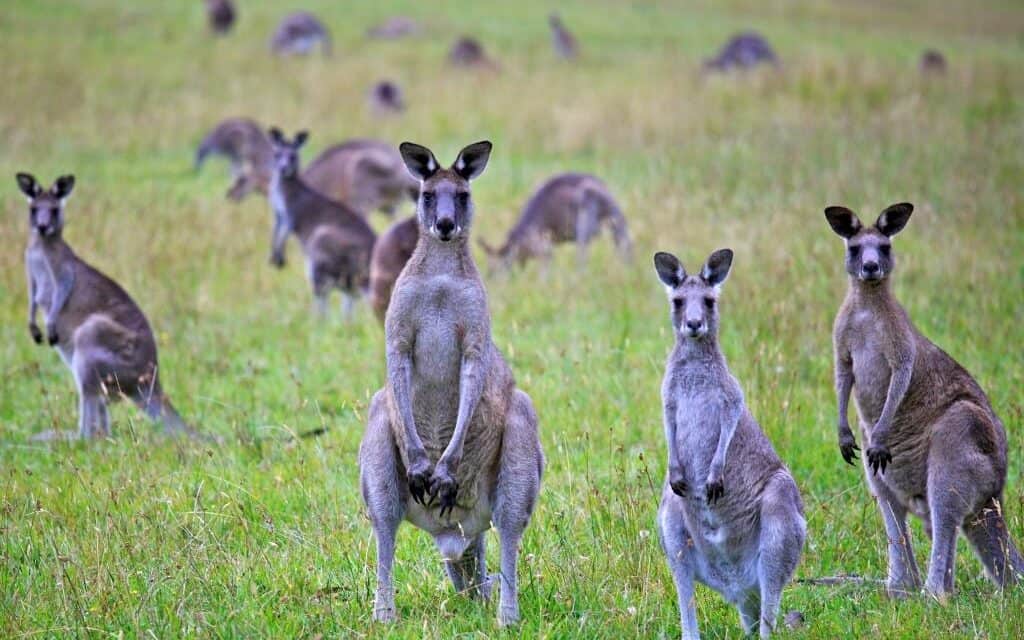Tanya Loos
I am driving a rental car at the moment while my Corolla is at the smash repairs in Castlemaine. Unfortunately they know me well – this is the fourth time they have replaced the front part of my car due to “road strike”, “wildlife collision”, “car strike” – this phenomenon has many names. Despite driving carefully and under the speed limit, each time it has seemed as if a kangaroo has come out of nowhere and collided with my little car! And at Gariwerd/ Halls Gap a few years ago, it was an Emu!
Eastern Grey Kangaroos have an incredible breeding system that allows for population explosions in times of good resource availability such as the triple dip La Nina we have experienced in recent years. They can have a baby in diapause, one in the pouch and a young at foot! For a wonderful description of kangaroo breeding biology and some adorable joey videos see https://southernforestlife.net/happenings/2018/1/17/eastern-grey-kangaroo-our-most-frequent-macropod-visitor
During the La Nina years, in the absence of predators such as dingoes and with water availability at an all time high due to the thousands of dams across the landscape, we now see huge mobs of eastern grey kangaroos – 70 to 150 animals – and then as you drive down the road there is another similar sized group.
But now that we are in the grip of a harsh localized drought, this big population of kangaroos is so very hungry. The absence of green feed in the paddocks has driven them to the roadsides where water run off and absence of stock equals a little more food.
If you drive at 70 km and under from dusk until dawn you can easily avoid hitting the roos eating grass on the side of the road. Once you spot them in your high beam, lower your lights to avoid dazzling them, and slowly drive past the group. I think most collisions occur when the animals are on the move.
Eastern Grey Kangaroos are a commuter species, using their incredibly efficient form of locomotion to bound across the landscape, moving from open feeding areas to sheltered rest spots and back again each day, particularly at dawn and dusk.
Like a truck bearing down, once a kangaroo is in full hopping mode it is difficult, if not impossible, to change direction. The roo’s natural response in the face of danger is to hop faster in an attempt to outrun the enemy – which often leads to it appearing as if the kangaroo is flinging itself at your car!
This may sound as if I am saying there is nothing we can do, but driving slower does make a difference. In the early 2000s, researchers surveyed over 15,000 km of Tasmanian roads. They compared the numbers of road-killed animals and the speed limits of the road they were found on and concluded that at a speed of 100 km an hour, a reduction of speed of just 20% (to 80 km an hour) would result in a reduction of road killed animals of around 50%! (Holiday and Minstrell, 2008)
For more detail on the issue, I recently made a submission into the Victorian Parliament’s Inquiry into wildlife roadstrike in Victoria – available here.
A few tips!
Slow down! I live in the Wombat Forest and the 50-km winding road between the train station and my home goes though forest patches, open farmlands and country estates. The speed limit is posted at 80–100 km an hour. At dusk and during the night, I choose to drive at speeds between 40 and 80 km an hour depending on the conditions, but usually at ~70 km an hour. These reduced speeds allow more time to scan the sides of the road for wildlife and increased reaction times to respond to any encounters.
Have emergency wildlife numbers in your phone: Wildlife Victoria 03 84007300. Make sure you call this number even if the animal hops away – as being able to move is no indication that the kangaroo is okay! The local police can also be called for compassionate euthanasia.
Donate or volunteer to our local wildlife shelters and Wildlife Victoria – they are absolutely overrun with the high volume of road strike!
References:
Hobday, A. J., & Minstrell, M. L. (2008). Distribution and abundance of roadkill on Tasmanian highways: human management options. Wildlife Research (East Melbourne), 35(7), 712–726. https://doi.org/10.1071/WR08067
Tanya Loos is a local naturalist, author and environmental consultant who loves to work in the environmental not-for-profit sector. She is the author of “Daylesford Nature Diary” available from her website or from Paradise Books in Vincent Street, Daylesford.
Have you got any nature questions for Tanya? Send them in!





